Communist Intelligence service successes - an overview of active and influence operations from the military hall of fame
In this article we present the active measures (AM) that found a place of honour in the Military Hall of Fame of the Czechoslovak intelligence service. According to the commissioned Chief of Czechoslovak intelligence Col. Ondrej Dovina this memorial room was to present "materials portraying the most famous operations and results of the intelligence service".1 These were operations of the Communist intelligence service after 1964, when, in connection with the establishment of the disinformation department, there was a great increase in activities. Even through historical operations, it is possible to observe a certain analogous continuity and to compare methods and their implementation with today's activities of post-Soviet secret services and their disinformation campaigns.
The military hall of fame was first established in 1977. It was set up in → the Centre (intelligence headquarters in Prague - Kobylisy) and showcased selected "achievements" within each division of intelligence activity. Active measures also had their own section. Probably the best-known operation of this kind today is active measure "Neptun". It was a joint operation between Czechoslovak intelligence and the KGB. The "chance" discovery of several crates in the Šumava's Black Lake containing numerous Nazi documents and the prepared media coverage surrounding the "discovery", was principally aimed at bringing into question and compromising German politicians.
However, this operation did not make it into the hall of fame. Its author - former Deputy Chief of Section 8 (active measures) Major Ladislav "Brychta" Bittman betrayed this information when he fled to the USA in 1968 and joined the group of Communist intelligence → defectors. The presentations of active measures in the hall of fame were filled by other, no less interesting, operations. Parts of active measures were also presented in the section devoted to the support of so-called national liberation movements. This involved particularly the support of the Cuban revolution.
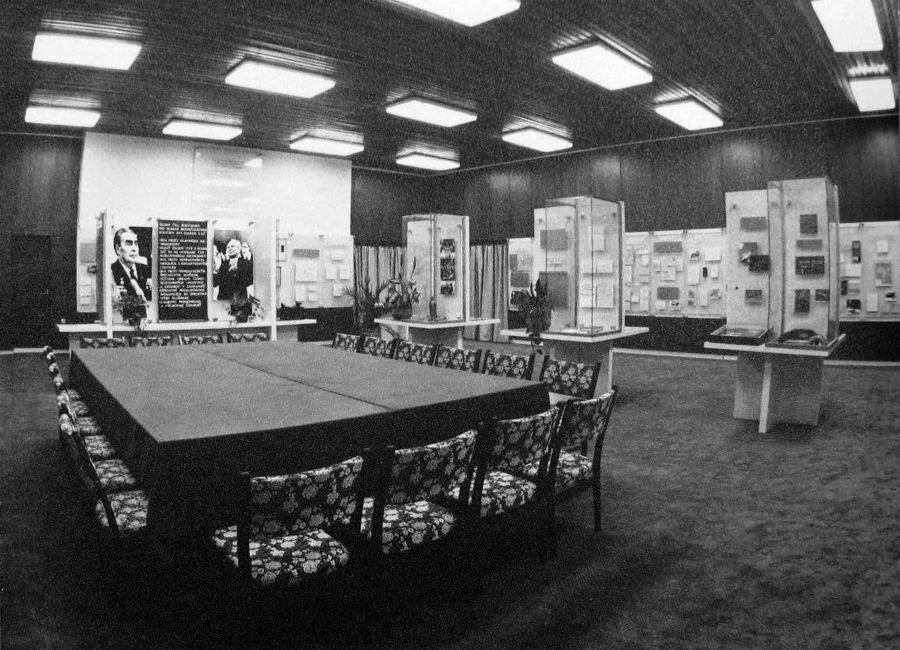
Fig. (Top) Military Hall of Fame of Czechoslovak intelligence with the conference table at which most cooperation treaties with friendly communist services were signed. (Below) Detail of a panel with the leaders of the USSR and Czechoslovak Socialist Republic. Source: ABS
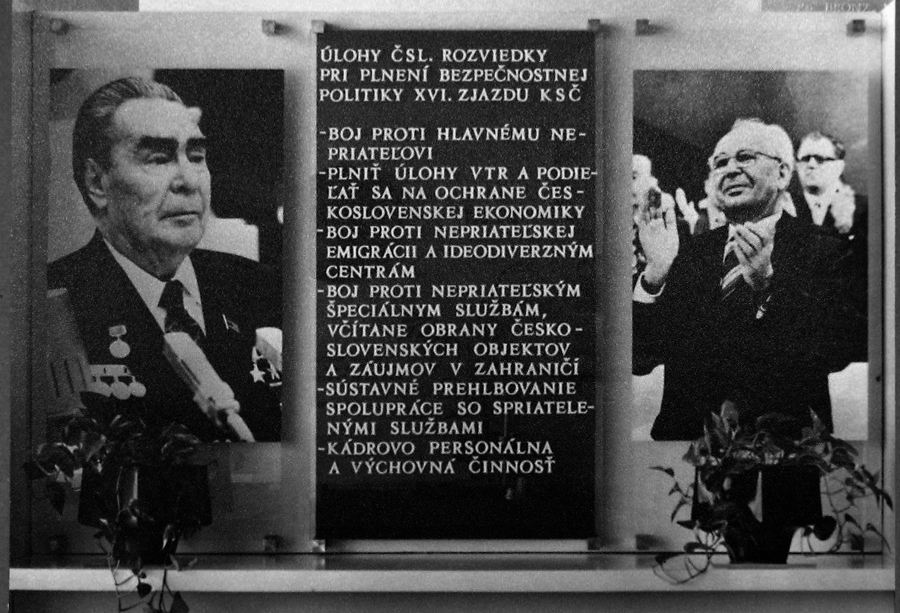
AM Karno
One of the oldest operations and one of the first panels in the hall of fame was an active measure (AM) from 1964 code named "KARNO" - this event was later deconspired and revealed to the West by Ladislav Bittman.2
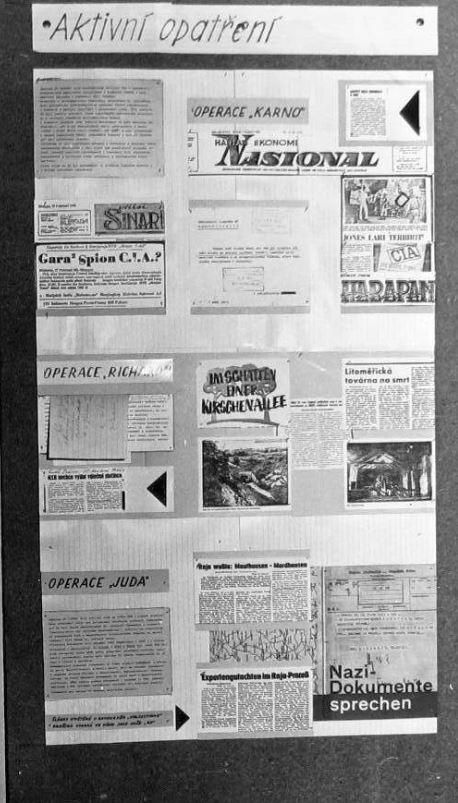
Anti-America themed materials, prepared by Czechoslovak intelligence were published by an agency4 managed by the residentura in Jakarta, in a series of reports in the Indonesian press. The reports were later taken up by other Indonesian media and triggered a significant anti-American backlash.
A series of mass demonstrations were held in front of the US Embassy in Jakarta, where demonstrators carried banners saying things like “Jones = Old CIA Spy”, “Jones go home” and so on. Students' and women's organizations asked President Sukarno to arrest Jones for his subversive activities.
The result of the AM was the expulsion of Palmer from Indonesia and the withdrawal of all US officers who were conducting military training there. All American companies in Indonesia were nationalized, political relations were broken and diplomatic ties were severed. The extensive repercussions of the AM were registered in top government circles and the general public.”5
 The most far-reaching consequences of this disinformation campaign, although it would be unfair to attribute them solely to the campaign itself, were ultimately the opposite of what its creators expected. 6 But even the death of thousands of alleged communists did not discourage the creators of panels for the most successful AMs from putting this operation in the hall of fame and successes of Communist intelligence.
The most far-reaching consequences of this disinformation campaign, although it would be unfair to attribute them solely to the campaign itself, were ultimately the opposite of what its creators expected. 6 But even the death of thousands of alleged communists did not discourage the creators of panels for the most successful AMs from putting this operation in the hall of fame and successes of Communist intelligence.
Fig. On 16 October 1965, President Sukarno appointed Gen. Suharta Commander of the Army (1967 - 1998 Second President of Indonesia), source: IPPHOS
In the ensuing chaos, on 2 October, with the support of the US, the commander of the KOSTRAD special forces General Suharto took power in the country, accused the Communist Party of Indonesia of attempting a coup and launched a violent liquidation of all communists and their sympathizers. Over the next six months, huge numbers of people were murdered in various places in Indonesia (estimates vary between half a million and two million). The Communist Party of Indonesia has been banned since 1966.
See: Collection of Declassified Documents of the US Embassy in Jakarta from 1965 about the Massacre of Indonesian Communists (National Security Archive)
AM Richard
Another operation, presented as one of the most successful active measures in the military hall of fame, affected the fate of "only" one person, the second president of the Federal Republic of Germany Heinrich Lübke7. The operation took place in 1966 and was codenamed "RICHARD". It was authored by Lt.Col. JUDr. Karl "FIKAR" Fremund, Deputy Chief of the disinformation Section 8 - from 1968 to 1969.8
The main aim was: “to contribute, together with other operations, to deferring the law on the non-prosecution of military crimes by the Federal Parliament and to draw the attention of the general public to the crimes committed by the Nazis during World War II at the company Richardwerke against prisoners of war and to the fact that the President of the Federal Republic Lübke bears the moral responsibility for these crimes.
The active measure was implemented in the form of an international press conference on concentration camp “Richard”. In addition, an exhibition of original documents on the topic was held. The conference was widely publicised by the Czechoslovak press (see below: articles from Rudé Právo on 16 June 1966 and 13 April 1967).
Czechoslovak Television broadcast a documentary including commentary from the underground premises of "Richard". Abroad, the conference was commented on in the press of socialist countries, especially in East Germany. East German television made a short film about the conference. References to the conference also made their way into the Western press.”9
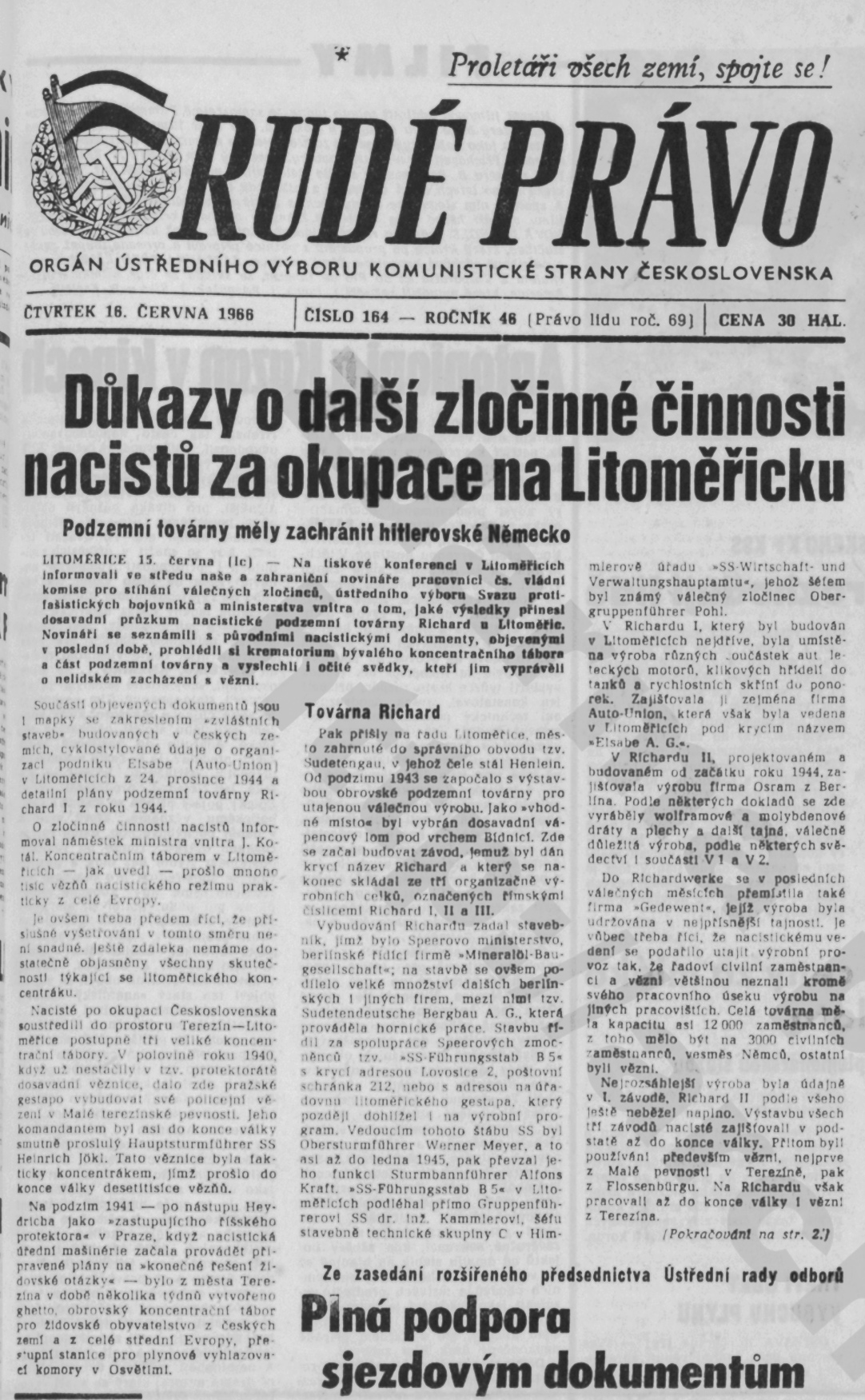
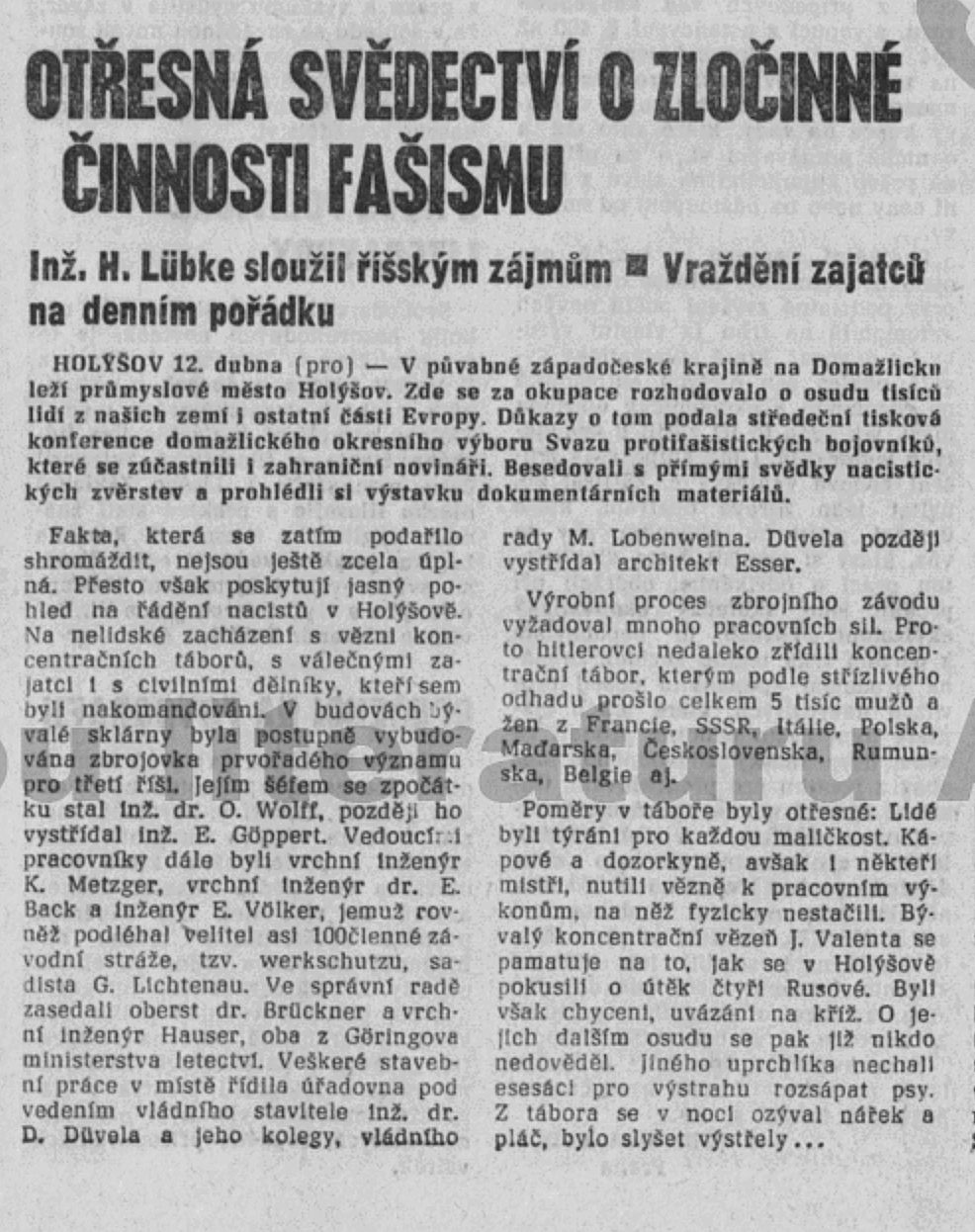 There were repeated attempts to discredit Heinrich Lübke by propagandists from East Germany and as mentioned by Petr Cajthaml, materials from a country that had clearly suffered at the hands of the Nazis had greater weight and credibility to the Germans and the Western public.10
There were repeated attempts to discredit Heinrich Lübke by propagandists from East Germany and as mentioned by Petr Cajthaml, materials from a country that had clearly suffered at the hands of the Nazis had greater weight and credibility to the Germans and the Western public.10
The AM presented the German President as one of the camp's architects.
It is clear that this disinformation campaign contributed to the early end of Lübke's term as president.
In 1974, the Czechoslovak embassy and, at the same time, the residentura in Bonn went into operation. Up until then, the intelligence service had operated in Germany through Czechoslovak companies in Frankfurt am Main, where workers were given cover roles as business partners of foreign trade companies (Motokov, Ferromet, Kovo, or the Ministry of Foreign Trade, ČSA, etc.) and also in West Berlin.
AM Juda
Original or "manufactured" materials from the Nazi era were fairly often used by Czechoslovak intelligence in its active measures. The third operation which made its way into the military hall of fame bore the code name "JUDA".
Its aim was “to put pressure on the government of West Germany (the Federal Republic of Germany) to extend the statute of limitations period for punishing Nazi war crimes. The basis for the AM was previously unpublished documents on the activities of the "Zentralstelle für jüdishe Aufswanderung" concerning the organization of transports of Jews and the responsibility of Hitler's Germany for the mass murder of Jews during World War II. Photocopies of documents were sent to several organizations in Czechoslovakia and abroad both officially and unofficially. Upon agreement with the RŽNO (Council of Jewish Religious Communities) in Prague, the government of West Germany was sent a protest letter by the RŽNO against the statute of limitations on war crimes. Copies of this letter were sent to 68 different organizations in 20 countries calling for protest.
The Jewish Documentation Centre in Vienna asked for more materials in a process against Rajkowitsch (?). It was given documents about Gestapo members Nölle and Gahleitner. The Europa-Verlag publishing house in Vienna incorporated the documents into a series of books on Nazi crimes. The RŽNO printed 1000 copies of a summary of the documents in brochure form (in German). Czechoslovak radio used the documents for international programs broadcast to German-speaking regions."11
These three active measures were, however, not the only ones that made it into the military hall of fame of Communist intelligence.
Operations supporting national-liberation movements
Other active measures presented to foreign delegations visiting the Centre were arranged in panels entitled "Aid to National Liberation Movements in 1962 - 1967" - Panel no. 10. and "Aid to National Liberation Movements" - Panel No.11.
Panel no. 10 presented mainly active measures aimed at “supporting” Cuba in the countries of Latin America (LA). In 1961 a long-term plan was prepared, in which the active measures Section analyzed the possibility of using the agents of individual residenturas in LA.
The aim of the most important AMs in support of Cuba (AM "Kuba", "Fox", "Družba", and "Plamen") was to organize "a broad support base in LA countries to defend the Cuban revolution against impeding American aggression".
Consequently, specific individual operations were described in the panels.
"A statement by the Committee of the Brazilian nationalist movement in support of Cuba – influencing the preparations for the establishment of a Brazilian Commission against American intervention in Cuba - distribution of posters with the slogan - "Yankee Hands off Cuba" - speeches by MPs in Brazilian parliament and publication in the press - articles on the training of counter-revolutionaries in Guatemala for an upcoming attack on Cuba. Articles against US domination in LA countries and against the continuing hostile policy of the US president - Brazilian Socialist Party's call to other parties in the country to speak out against US aggression against Cuba – meeting of the Brazilian Democratic Lawyers Association endorsed the call condemning US aggression against Cuba – the call was sent out to the UN, OAS, and the US embassy in Cuba and various other international institutions.
Distribution of progressive books about Cuba among Brazilian army officers - Issuing of a manifesto with a petition in support of Cuba against American aggression - the manifesto was distributed to all Latin American embassies in Brazil, the UN, the OAS, and the press - organizing a demonstration of 40,000 people in Porto Alegre - lectures for students about the significance of the Cuban revolution - painting of pro-Cuban slogans on the streets and putting up of posters by students…
...Organization of movements in LA countries to set up committees to support Cuba - mass disclosure of cases of abuse of the Riga Pact by the US against Cuba – discreditation of the OAS, in particular its measures against Cuba, by legal analysis of the OAS Charter (book) – discreditation of the activities of Cuban counter-revolutionaries before the public in LA countries (Active Measure Plamen), the aim of which was to disrupt the cooperation between Argentina and the US in the preparation of special strike forces for guerrilla warfare against Cuba.
Sending of a fake letter by an Argentinian student, allegedly working at army headquarters, to student and trade union organizations, and the RIVADAVIA radio station, revealing preparations for the use of Argentinians in subversive operations against Cuba. The contents of the letter were broadcast by RIVADAVIA, accompanied by criticismof these preparations and a call for the relevant Argentinian officials to take the proper stance on the matter"12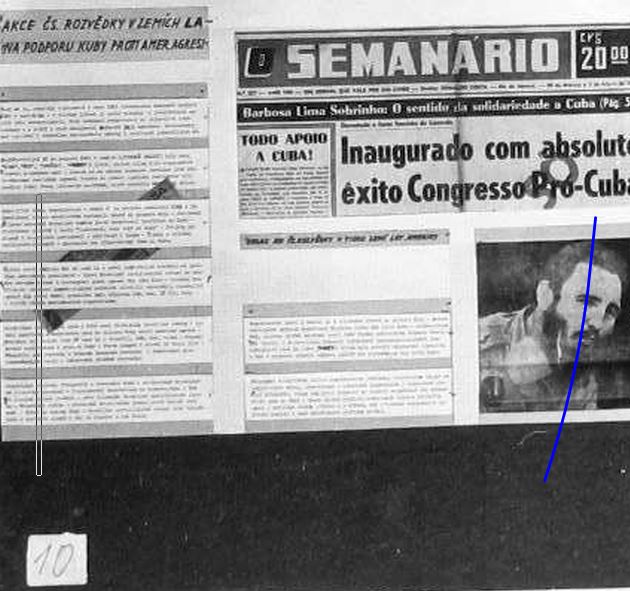
AM Plameň
A not dissimilar measure presented on another panel was e.g. AM "Plameň" against US aggression in Panama in 1964.13
It was a continent-wide chain reaction operation, which was also extended to Africa and Asia. All residents in the area were involved in its implementation.
Mexico
The dispatching of two agents to Panama to obtain material for an anti-American article in the MexicanPress - Coordinated dispatching of telegrams to the president of Panama, the USA, UN, OAS, student and other organizations - In addition to these events, public protest rallies were also arranged.
Colombia
A meeting of the National Executive Committee of the Liberal-Youth-Revolutionary Movement was organized, where it was agreed to set up a National Committee for Solidarity with Panama and decisions were made on the program for a solidarity week during which there would be student demonstrations, meetings with Panamanian embassy officials and the establishment of troops to defend Panama.
Argentina
As part of this operation, a letter of solidarity with Panamawas sent in the name of the Argentine institute NOTO (?) to the President of Panama. The letter was handed to the Argentine press – The circulation of smaller banknotes in the local currency bearing anti-American slogans was organized in these countries.
Brazil
Agents arranged solidarity events involving Brazilian students (rallies, etc.), opinion pieces were published in the press against US intervention in Panama, dissenting speeches were made in Parliament, radio programs and trade union meetings.
Uruguay
Protest rallies were arranged at universities, a public statement by the Uruguayan Socialist Party and its youth organization against American aggression, opinion pieces in the press, anti-American commentary on Radio-Nacional, etc.
Bolivia
The sending of protest letters and expressions of solidarity with the people of Panama by Bolivian students was organized - a resolution of the University Council of Cochabamba condemning US intervention in Panama was issued.
Mali
The sending of a telegram by the PAI Party of Senegal 14 to the Panamanian Government and the UN against aggressive action by the US in support of Panama and its independence, as well as trade union action promoting solidarity with the people of Panama, was arranged.
Nigeria
An article in support of Panama against American aggression was published in the Sunday Express newspaper.
Ghana
The publication of an anti-American article on the Panama issue was arranged, telegrams were sent to the President of Panama and the Secretary General of the OAS,condemning US aggression against Panama - Trade unions were informed of the situation by internal briefs.
India
OUTLOOK published an anti-American article on the Panama problem.
Indonesia
Anti-American articles on Panama were printed in the local press – commentary was broadcast on Indonesian radio – an Indonesian student organization sent a protest petition to the US embassy and telegram expressing solidarity with Panamanian students.
Lebanon
AS CHAAB published an article against US aggression in support of Panama.15
Author: Martin Slávik
1 ABS f. I. S-ZNB. SF 042. .pg 101.
4 Understand: through an agent.
5 ABS f. I. S-ZNB. SF 042. pg 151.
6 Encouraged by their success, Indonesian communists, with the tacit approval of President Sukarno, attempted a coup, initially linked to the murder of six high-ranking Indonesian generals. However, the army came down hard in response - in its operation directed mainly against the Communist Party of Indonesia, more than 300,000 people were killed, and the until-then most powerful political entity, the Communist Party of Indonesia, was driven underground.
7 Heinrich Lὒbke - President of the Federal Republic of Germany from 1959 to 1969.
8 A detailed study of this StB member, including information about his participation in the activities of the Active Measures Section, was written for example by Petr Cajthaml: https://www.abscr.cz/data/pdf/sbornik/sbornik4-2006/kap04.pdf
9 ABS f. I. S-ZNB. SF 042. pg 151.
10 See Petr Cajthaml: https://www.abscr.cz/data/pdf/sbornik/sbornik4-2006/kap04.pdf
11 ABS f. I. S-ZNB. SF 042. pg 152.
12 ABS f. I. S-ZNB. SF 042. pg 144.
14 The Independence and Labour Party – a socialist party with communist roots
15 ABS f. I. S-ZNB. SF 042. p 148-149.



